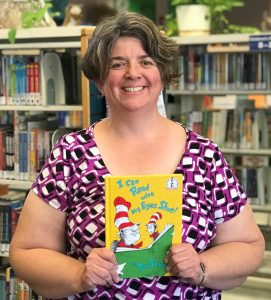This article by Librarian Michelle Creston was originally published in the Arizona Daily Star on Apr. 29, 2018.
My love of children’s literature has led me to the best job in the entire library.
I’m so lucky: I’m the youth librarian in the Collection Development Office at the Pima County Public Library.
What does that mean? I have the honor and responsibility of selecting children’s and young-adult materials we carry in our library system (all 26 locations). It’s not just about picture books, either. I select board books, readers, chapter books, graphic novels, manga, DVDs, audiobooks and ebooks.
My job is no small task. Did you know that we stock 71,000 unique titles — and multiple copies of most of them — for children and young adults? Last year alone, I ordered 5,500 new titles.
The library is always striving to meet the needs of our eager young library users, whether they’re looking for books to read purely for fun or those required for research and homework assignments. Since all of our library locations serve their own unique community, our staff is always making recommendations on the popular items their customers need.
Choosing quality titles requires a good deal of research. I spend a lot of time searching for new authors, analyzing trends and considering materials. For example, I have to make sure that nonfiction receives as much consideration as fiction and that there are always plenty of classics on the shelves.
In most cases, I don’t have the actual book in hand, so I rely heavily on book reviews . We also receive lists of best-selling books from our distributor (the friendly folks we get the books from). It takes a lot of planning. Holiday books, for example, are ordered several months ahead of time.
Every child gains valuable early literacy skills when they are read to daily. As you may have guessed, picture books are definitely the most popular. Parents and caregivers check them out by the armful. Publishers are releasing such incredible picture books these days — it’s quite difficult not to order them all. Plus, picture books offer a way to introduce difficult topics. Some books help explain why grandma doesn’t remember them, or provide help when a beloved pet dies.
STEAM (Science, Technology, Engineering, Arts and Math) is essential for today’s 21st century learners. Our libraries feature numerous nonfiction titles to meet the needs of curious students. Computer coding for girls is currently a hot topic. The new chapter books series “Girls Who Code” helps to inspire and encourage readers to study these subjects.
Some experts believe even babies can be introduced to nonfiction topics. You might be surprised to find board books on gravity, the solar system and even quantum physics. Perhaps you’ve heard of author Chris Ferrie? His series includes such titles as “Rocket Science for Babies,” “General Relativity for Babies” and “Newtonian Physics,” among many others.
Currently it’s challenging to find books about ethnicities, genders, sexual orientations and abilities.
Our collection strives to reflect the diverse population of Pima County. My goal is to make sure every child has the opportunity to see characters who look like him or her in the books they read. Not only does this help show them how they fit into the community and the world, it also helps validate them as individuals.
One thing I find exciting is more and more diverse titles are released every year. We have books for every age that feature people of color, LGBTQ+ characters and people with disabilities. A few I’d recommend checking out include “Jabari Jumps” by Gaia Cornwall, “George” by Alex Gino, “Days with Dad” by Nari Hong, and “The Big Umbrella” by Amy June Bates. Books are an incredible tool to help children gain empathy by reading about other cultures and walking in someone else’s footsteps.
There are approximately 23,000 young-adult titles in the collection. Popular genres include social-justice issues, dystopian science fiction and relationships. Graphic novels, or bound comics, rely on elaborate illustrations to help tell the story. Contrary to popular belief, not all graphic novels are about superheroes or zombies. Many tackle more difficult topics, such as mental health or poverty. In fact, some popular fiction has recently been released in newly illustrated versions, like Laurie Halse Anderson’s award-winning “Speak.”
One Sunday a month, I get to work with the public at the Himmel Park Library. The children’s area is always full of kids and parents looking for books, doing puzzles, coloring or using the computer. I love helping young customers find the perfect book and seeing what items are most popular.
It’s long been my belief that the universe led me to this job. I’ve always loved reading children’s books and still get excited by new picture books. I was lucky my dad encouraged me to read as a child. Every Saturday he took me to the Woods Memorial Library, where I would check out enormous stacks of books.
Then I would disappear for hours, devouring the words until I read them all and I would beg my dad to take me back to the library for more.
My love for children’s and young-adult literature still continues today. How lucky am I to have this job? Very lucky indeed.
Michelle Creston has lived in Tucson since she was 6 and has worked for the Pima County Public Library for 12 years. She’s a Disney fan and LEGO builder. Her favorite Dr. Seuss book to read out loud is “I Can Read With My Eyes Shut!”



